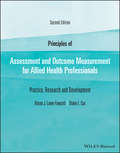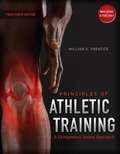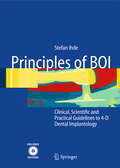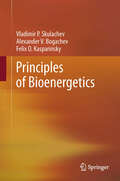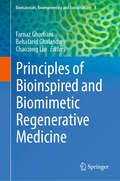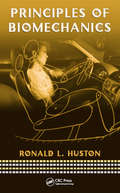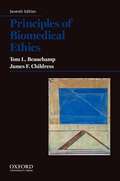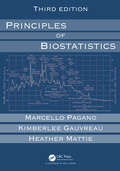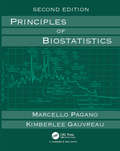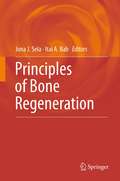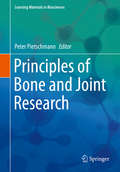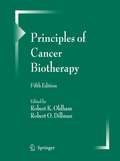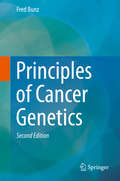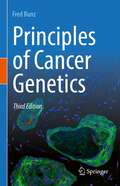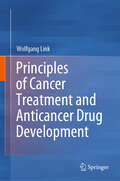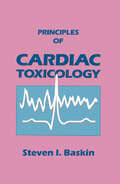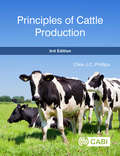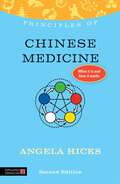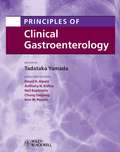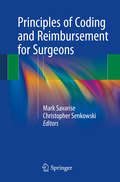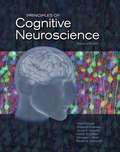- Table View
- List View
Principles of Assessment and Outcome Measurement for Allied Health Professionals: Practice, Research and Development
by Alison Laver-Fawcett Diane L. CoxPrinciples of Assessment and Outcome Measurement for Allied Health Professionals The revised and updated second edition of Principles of Assessment and Outcome Measurement for Allied Health Professionals offers an authoritative guide for allied health professionals and students. The authors, noted experts on the topic, explore the assessment process that encompasses the data collection methods, the evaluation process that determines the effectiveness of an intervention, and standardised and systematic outcome measurement procedures. The book discusses in detail the various methods of data collection (observation, interview, standardised testing) and the types of sources (self-report, proxy, observational) for collecting information. The main purposes of assessment (descriptive, evaluative, predictive, discriminative) are also presented. The book addresses the topics of standardization, levels of measurement, reliability, validity, and clinical usefulness. The text provides the information needed to select and perform assessment and outcomes measurement to inform goal setting, evaluate outcomes, and ensure that interventions are effective, efficient, and economical in order to provide quality services to clients and their carers. This important book: Covers information on assessment and measurement in practice, research, and service evaluation and improvementExplores how to develop and evaluate assessments and outcome measuresOffers an international perspectiveDiscusses the criteria for choosing a particular assessment approachInforms the critical appraisal of the evidence underpinning standardised assessments and measures, and selecting the best tools for practice or researchIncludes updated and additional case studiesProvides worksheets and additional illustrations to enhance understandingWritten for allied health students and professionals, Principles of Assessment and Outcome Measurement for Allied Health Professionals is the essential guide to assessing, measuring, and evaluating the impact and outcome of clinical practice and interventions.
Principles of Assessment and Outcome Measurement for Occupational Therapists and Physiotherapists
by Alison Laver FawcettThis textbook on assessment and outcome measurement is written for both occupational therapy and physiotherapy students and qualified therapists. It begins by defining what is meant by assessment, outcome, evaluation and measurement and discussing the complexity of therapy assessment and measurement, including the challenge of measuring human behaviour and the impact of factors such as task demand and context, including the environment. Methods of data collection (e.g. observation, interview, standardised testing) and sources (e.g. self-report, proxy) for collecting information about clients are then reviewed, and the main purposes of assessment (e.g. descriptive, evaluative, predictive, discriminative) presented. The book then addresses the topics of standardisation, levels of measurement, reliability, validity and clinical utility. There is a chapter describing and applying models for categorizing levels of function to aid assessment and measurement. The concept of clinical reasoning and reflective practice is then explored. Application of principles is supported through detailed case studies and worksheets and the criteria for test critique and guidelines for choosing a particular assessment approach are discussed.
Principles of Athletic Training: A Competency-Based Approach (Fourteenth Edition)
by William E. Prentice Daniel D. ArnheimThis text emphasises the prevention and management of athletic injuries and covers all aspects of the profession of athletic training. It provides practical, career-oriented content for students in athletic training, sports medicine, physical education, physical therapy and coaching.
Principles of BOI
by Stefan IhdeBasal Osseointegration as a procedure developed on the basis of disc implantology is the method most commonly used for the unilateral treatment of advanced maxillary atrophy. The method is extremely well developed, because it was refined over a period of decades exclusively by practitioners and become established independently of the universities. The treatment aim can be achieved safely, easily and at low cost. Principles of BOI is most practical and explains exactly how things work. It provides treatment plans, tricks and pitfalls and step-by step guidance.
Principles of Bioenergetics
by Alexander V. Bogachev Felix O. Kasparinsky Vladimir P. SkulachevPrinciples of Bioenergetics summarizes one of the quickly growing branches of modern biochemistry. Bioenergetics concerns energy transductions occurring in living systems and this book pays special attention to molecular mechanisms of these processes. The main subject of the book is the "energy coupling membrane" which refers to inner membranes of intracellular organelles, for example, mitochondria and chloroplasts. Cellular cytoplasmic membranes where respiratory and photosynthetic energy transducers, as well as ion-transporting ATP-synthases (ATPases) are also part of this membrane. Significant attention is paid to the alternative function of mitochondria as generators of reactive oxygen species (ROS) that mediate programmed death of cells (apoptosis and necrosis) and organisms (phenoptosis). The latter process is considered as a key mechanism of aging which may be suppressed by mitochondria-targeted antioxidants.
Principles of Bioinspired and Biomimetic Regenerative Medicine (Biomaterials, Bioengineering and Sustainability #3)
by Farnaz Ghorbani Behafarid Ghalandari Chaozong LiuNature has developed a diverse of materials, structures, and processes that are highly optimized for various functions. Through the field of biomimicry and bioinspiration, engineers are enhancing their understanding of natural design principles and applying these insights to create complex engineering models across different scales. These innovative approaches are particularly appropriate to address challenges in tissue engineering and regenerative medicine. Natural materials and systems exhibit a diverse array of functions, including but not limited to structural support, signal transduction, charge transfer, self-assembly, self-organization, and self-replication. Consequently, nature&’s "solution manual" is remarkably comprehensive. Despite significant advancements, the reconstruction of nature-inspired designs using synthetic materials presents ongoing challenges. As a result, nature and bioinspired materials and architectures have emerged as a paradigm shift within the realm of tissue engineering and regenerative medicine. This comprehensive guide aims to provide scientists with inspiration to address a variety of critical challenges in tissue regeneration by directly applying established design principles. A key focus of this volume is the utilization of bioinspired architectures in tissue engineering. It also emphasizes the development of nature-inspired structures through the integration of novel biological macromolecules, bioinspired polymers and hydrogels, as well as biomimetic ceramics. Furthermore, the text concentrates on the biochemical and biophysical dimensions of bioinspired surface engineering. Both dry-lab and wet-lab methodologies for characterizing nature and bio-inspired materials and structures are also addressed. The publication seeks to promote the development of high-level translational knowledge among both established and emerging scientists.
Principles of Biomechanics
by Ronald HustonResearch and study in biomechanics has grown dramatically in recent years, to the extent that students, researchers, and practitioners in biomechanics now outnumber those working in the underlying discipline of mechanics itself. Filling a void in the current literature on this specialized niche, Principles of Biomechanics provides readers with a so
Principles of Biomedical Ethics
by Tom L. Beauchamp James F. ChildressBuilding on the best-selling tradition of previous editions, Principles of Biomedical Ethics, Seventh Edition, provides a highly original, practical, and insightful guide to morality in the health professions. Acclaimed authors Tom L. Beauchamp and James F. Childress thoroughly develop and advocate for four principles that lie at the core of moral reasoning in health care: respect for autonomy, nonmaleficence, beneficence, and justice. Drawing from contemporary research--and integrating detailed case studies and vivid real-life examples and scenarios--they demonstrate how these prima facie principles can be expanded to apply to various conflicts and dilemmas, from how to deliver bad news to whether or not to withhold or withdraw life-sustaining treatments. Illuminating both theory and method throughout, Principles of Biomedical Ethics, Seventh Edition, considers what constitutes moral character and addresses the problem of moral status: what rights are due to people and animals, and when. It also examines the professional-patient relationship, surveys major philosophical theories--including utilitarianism, Kantianism, rights theory, and virtue theory--and describes methods of moral justification in bioethics. Ideal for courses in biomedical ethics, bioethics, and health care ethics, the text is enhanced by hundreds of annotated citations and a substantial introduction that clarifies key terms and concepts.
Principles of Biostatistics
by Marcello Pagano Kimberlee Gauvreau Heather MattiePrinciples of Biostatistics, Third Edition is a concepts-based introduction to statistical procedures that prepares public health, medical, and life sciences students to conduct and evaluate research. With an engaging writing style and helpful graphics, the emphasis is on concepts over formulas or rote memorization. Throughout the book, the authors use practical, interesting examples with real data to bring the material to life. Thoroughly revised and updated, this third edition includes a new chapter introducing the basic principles of Study Design, as well as new sections on sample size calculations for two-sample tests on means and proportions, the Kruskal-Wallis test, and the Cox proportional hazards model. Key Features: Includes a new chapter on the basic principles of study design. Additional review exercises have been added to each chapter. Datasets and Stata and R code are available on the book’s website. The book is divided into three parts. The first five chapters deal with collections of numbers and ways in which to summarize, explore, and explain them. The next two chapters focus on probability and introduce the tools needed for the subsequent investigation of uncertainty. It is only in the eighth chapter and thereafter that the authors distinguish between populations and samples and begin to investigate the inherent variability introduced by sampling, thus progressing to inference. Postponing the slightly more difficult concepts until a solid foundation has been established makes it easier for the reader to comprehend them.
Principles of Biostatistics (Statistics Ser.)
by Marcello Pagano Kimberlee Gauvreau<p>This edition is a reprint of the second edition published in 2000 by Brooks/Cole and then Cengage Learning. <p>Principles of Biostatistics is aimed at students in the biological and health sciences who wish to learn modern research methods. It is based on a required course offered at the Harvard School of Public Health. In addition to these graduate students, many health professionals from the Harvard medical area attend as well. <p>The book is divided into three parts. The first five chapters deal with collections of numbers and ways in which to summarize, explore, and explain them. The next two chapters focus on probability and introduce the tools needed for the subsequent investigation of uncertainty. It is only in the eighth chapter and thereafter that the authors distinguish between populations and samples and begin to investigate the inherent variability introduced by sampling, thus progressing to inference. Postponing the slightly more difficult concepts until a solid foundation has been established makes it easier for the reader to comprehend them.
Principles of Bone Regeneration
by Jona J. Sela Itai A. BabPrinciples of Bone Regeneration is a timely publication that addresses the modern aspects of bone healing and repair. This exciting new volume details the convergence of the different experimental and clinical approaches designed for the study and treatment of bone healing in its diverse forms and under varying conditions. Bone healing is affected by a multitude of genetic, environmental, mechanical, cellular and endocrine variables which eventually lead to changes in gene expression that enhance the guided action of osteoblasts (and chondroblasts) to lay down bone that restores, or even improves, the skeletal load bearing capacity. Recent breakthroughs in understanding the regulatory aspects of bone formation and resorption, in both research and clinical arenas offer new modalities to induce, enhances and guide repair processes in bone for the benefit of millions of patients with conditions such as nonunion fractures, critical size defects, orthodontic tooth movement, periodontal bone loss, intraosseous implants and deformed bones.
Principles of Bone and Joint Research
by Peter PietschmannThis textbook discusses the basics and clinical aspects of bone research in an accessible way. It aims at enhancing students' understanding of the structure, pathophysiology and regeneration of bone and associated connective tissues. The book covers a diverse aspects of this interdisciplinary field, including immunology, molecular biology and regenerative medicine, as well as tissue engineering and strategies that combine biomaterials, cells and growth-stimulating factors to trigger tissue development and regeneration. As such, the book offers an essential guide for advanced master's students and PhD students in biomedicine, orthopedics and rheumatology.
Principles of Cancer Biotherapy
by Robert K. Oldham Robert O. DillmanAt the time of the first edition of Principles of Cancer Biotherapy in 1987, this book represented the first comprehensive textbook on biological therapy. In 1991, when the second edition was published, there was still some doubt on the part of many oncologists and cancer researchers as to the therapeutic value of these new approaches. By 2003 and the fourth edition, it was generally agreed that biopharmaceuticals were producing major opportunities for new cancer therapies. Cancer biotherapy has now truly matured into the fourth modality of cancer treatment. This fifth revised edition describes the tremendous progress that has been made in recent years using biologicals in cancer treatment. This book summarizes an evolving science and a rapidly changing medical practice in biotherapy. In this new millennium, it is now possible to envision a much more diversified system of cancer research and treatment that will afford greater opportunities for a patient's personalized cancer treatment. This was first envisioned in the 1987 initial edition of this textbook and is now a "new" and popular approach to cancer treatment. Some forms of cancer biotherapy use the strategy of tumor stabilization and control through continued biological therapy, akin to the use of insulin in the treatment of diabetes. This textbook illustrates new methods of thinking and new strategies for control of cancer. It is always difficult to move from past dogma to future opportunity, but this fifth edition of Principles of Cancer Biotherapy illustrates why it is so important to the patients for researchers and clinicians to explore and quickly apply these new opportunities in cancer biotherapy.
Principles of Cancer Genetics
by Fred BunzThis is the second edition of a widely used textbook that consolidates the basic concepts of the cancer gene theory and provides a framework for understanding the genetic basis of cancer. Particular attention is devoted to the origins of the mutations that cause cancer, and the application of evolutionary theory to explain how the cell clones that harbor cancer genes tend to expand. Focused on the altered genes and pathways that cause the growth of the most common tumors, Principles of Cancer Genetics is aimed at advanced undergraduates who have completed introductory coursework in genetics, biology and biochemistry, medical students and medical house staff. For students with a general interest in cancer, this book provides a highly accessible and readable overview. For more advanced students contemplating future study in the field of oncology and cancer research, this concise book will be useful as a primer.
Principles of Cancer Genetics
by Fred BunzThis popular textbook, now in its third edition, provides a theoretical framework for understanding why cancers arise, how they develop and how they can be treated.Particular attention is devoted to the origins of cancer and the application of evolutionary theory to explain how mutant cell populations tend to expand and spread. Focused on the genes and signaling pathways involved in the most common tumors, Principles of Cancer Genetics is a highly readable account that will be of interest to anyone who would like to attain a basic understanding of cancer biology. Students who have completed introductory coursework in genetics, biology and biochemistry, medical students and medical house staff will find this book to be a useful starting point toward mastery of this complex but fascinating topic. This updated edition delves into the critical interactions between growing tumors and the immune system, and introduces the concepts of T cell activation, immunoediting and immune evasion. Novel strategies for cancer diagnosis and prognosis, including new roles for next-generation sequencing and liquid biopsies, as well as established and emerging therapeutic modalities are now described in detail.For laypersons, students and researchers in other fields with a general interest in cancer, this book provides an accessible overview, enriched with many easy-to-understand illustrations. For advanced students considering future study in the field of oncology and cancer research, this concise book is a useful guide to the basic principles that underlie our understanding of cancer.
Principles of Cancer Treatment and Anticancer Drug Development
by Wolfgang LinkThis book explains how current medicines against cancer work and how we find new ones. It provides an easy-to-understand overview of current options to treat patients with cancer, which includes Surgery, Radiation therapy, Chemotherapy, Targeted therapy and Immunotherapy. The efficiency of all these treatments is limited by the capacity of cancer cells to escape therapy. This book explains the mechanisms of anti-cancer drug resistance and strategies to overcome it. The discovery and development process of a new drug is detailed beginning with the identification and validation of a therapeutic target, the identification of an inhibitor of the target and its subsequent preclinical and clinical development until its approval by regulatory authorities. Particular emphasis has been given to specific aspects of the development process including lead generation and optimization, pharmacokinetics, ADME analysis, pharmacodynamics, toxicity and efficacy assessment, investigational new drug (IND) and new drug application (NDA) and the design of clinical trial and their phases. The book covers many aspects of modern personalized oncology and discusses economic aspects of our current system of developing new medicines and its impact on our societies and on future drug research. The author of this book, Dr. Link counts with more than 20 years of experience in biomedical research reflected in numerous publications, patents and key note and plenary presentations at international conferences. Interested readers, students and teachers should read this book as it provides a unique way to learn/teach about basic concepts in oncology and anti-cancer drug research.
Principles of Cardiac Toxicology
by Steven I. BaskinWhat chemicals are poisonous to the heart and why are they toxic?Find out by reading Principles of Cardiac Toxicology. Certain chemicals can produce toxicity by interacting with elements of the cardiovascular system. This book presents the anatomical, physiological, biochemical, and pathological basis for this interaction and describes the
Principles of Cattle Production
by Clive PhillipsCompletely updated and revised, the new edition of Principles of Cattle Production continues to provide an introductory level text for all interested in dairy and beef cattle production systems. This edition presents a vision for a cattle industry that addresses issues about impacts on the environment, the welfare of cattle and the provision of safe and high quality food for an increasingly demanding world population. The new edition: - Is expanded to include more on animal welfare, sustainability and production systems in low and middle income countries, including smallholder production systems. - Has undergone a thorough review of all the existing chapters, with new content on the future role of cattle. - Contains quality colour illustrations, so that key information can be found at a glance. - Is beautifully written with many examples and pointers for further information. - Tackles key issues of sustainability and the requirement for increased production. - Now contains helpful exercises and other resources for students and their teachers to consider the role of cattle in the world today and in the future. Principles of Cattle Production 3rd Edition continues to provide a comprehensive yet concise overview for all undergraduate students of animal science, agriculture, veterinary medicine, animal welfare and industry personnel.
Principles of Cattle Production
by Clive PhillipsCompletely updated and revised, the new edition of Principles of Cattle Production continues to provide an introductory level text for all interested in beef and dairy cattle production systems. This edition presents a vision for a cattle industry that addresses the environment, the welfare of cattle and the provision of safe and high quality food for an increasingly demanding world population. The new edition: - Is expanded to include more on animal welfare, sustainability and production systems in low and middle income countries, including smallholder production systems. - Has undergone a thorough review of all the existing chapters with new content on breeding cattle and the future role of cattle. - Contains quality colour illustrations, so that key information can be found at a glance. - Is beautifully written with many examples and pointers for further information. - Tackles key issues of sustainability and the requirement for increased production. Principles of Cattle Production 3rd Edition continues to provide a comprehensive yet concise overview for all undergraduate students of animal science, agriculture, veterinary medicine, animal welfare and industry personnel.
Principles of Chinese Medicine: What it is, how it works, and what it can do for you Second Edition
by Angela HicksAcupuncture, Chinese herbs, qigong, tui na massage and diet therapy have been used by the Chinese for over 2000 years, and they are still the treatments of choice for millions of people throughout the East. Now, Westerners are becoming aware of the many benefits of these potent therapies and the popularity of Chinese medicine is spreading rapidly. Covering everything from the basic theory of Chinese medicine to how to find a practitioner, the book provides a definitive introductory guide to this ancient system. It includes explanations of each of the five therapies and their unique benefits as well as patients' first-hand experiences. With advice on choosing the right treatment, and comprehensive sections on useful addresses and further reading, the book provides everything readers need to know about Chinese medicine at an introductory level. A practical handbook that provides all of the essential information, this book is the perfect introduction for anyone who wants to find out more about Chinese medicine, whether as a treatment option or for general interest.
Principles of Clinical Cancer Genetics
by Daniel A. Haber Daniel C. ChungAdvances in genetics are transforming estimates of an individual's risk of developing cancer and approaches to prevention and management of cancer in those who may have increased susceptibility. Identifying and caring for patients with hereditary cancer syndromes and their family members present a complex clinical, scientific and social challenge. This textbook, by leading experts at Massachusetts General Hospital Cancer Center, highlights the current understanding of the genetics of hereditary cancers of the breast, ovary, colorectum, stomach, pancreas, kidney, skin, and endocrine organs. Practical guidelines for the use of genetic testing, cancer screening and surveillance, prophylactic surgery, and promising targeted therapeutic agents are discussed. In addition, ongoing research involving genome-wide screens to identify novel modest risk-associated genetic loci are explored, along with new approaches to the application of genetic markers in guiding therapeutic options.
Principles of Clinical Gastroenterology
by Neil Kaplowitz Anthony N. Kalloo Chung Owyang Don W. Powell David H. AlpersA Concise, Symptom-Based Textbook for Diagnosis and Decision Making in Clinical Practice Over the past twenty years, thousands of physicians have come to depend on Yamada’s Textbook of Gastroenterology. Its encyclopaedic discussion of the basic science underlying gastrointestinal and liver diseases as well as the many diagnostic and therapeutic modalities available to the patients who suffer from them was—and still is—beyond compare. This new textbook, Principles of Clinical Gastroenterology, is designed to inform practitioners on the features of the major clinical disorders in gastroenterology and hepatology from the point of view of the clinician observing signs and symptoms of a patient under care and management. It is a practical guide to diagnosis and decision making in clinical practice and provides a rich source of information on diseases of the gastrointestinal tract and liver. Covering the full range of examinations in gastroenterology and hepatology, with extremely timely chapters on patients with dyspepsia, eating disorders, jaundice, hepatitis, cirrhosis, and on screening, Principles of Clinical Gastroenterology gives you easy access to approaches that a clinician might take to common symptoms and signs presented by patients with such disorders. The chapters include the epidemiology, history, signs and symptoms, diagnosis, treatment, and prognosis of the most commonly encountered disorders in gastroenterology and hepatology. This textbook will be an invaluable resource whether you are a gastroenterologist, internist, surgeon, or other clinician who sees patients with gastrointestinal and liver disorders. It should be kept close at hand for frequent consultation.
Principles of Clinical Medicine for Space Flight
by Michael R. Barratt Ellen S. Baker Sam L. PoolIn its first edition, Principles of Clinical Medicine for Space Flight established itself as the authoritative reference on the contemporary knowledge base of space medicine and standards of care for space flyers. It received excellent notices and is used in the curricula of civilian and military training programs and used as a source of questions for the Aerospace Medicine Certifying Examination under the American Board of Preventive Medicine. In the intervening few years, the continuous manning of the International Space Station has both strengthened existing knowledge and uncovered new and significant phenomena related to the human in space. The Second Edition incorporates this information. Gaps in the first edition will be addressed with the addition new and revised chapters. This edition is extensively peer reviewed and represents the most up to date knowledge.
Principles of Coding and Reimbursement for Surgeons
by Mark Savarise Christopher SenkowskiThis text provides the in-depth understanding of the mechanisms that guide coding and reimbursement. The text is meant to be useful to surgeons in practice, both in general surgery and in surgical subspecialties; practice management teams of surgical practices and to resident physicians in surgery. Part 1 of the text addresses the CPT coding process, the relative valuation system (RVU), the ICD-9 and ICD-10 systems of classification, Medicare Part B payment rules for physicians, the DRG system and Medicare Part A payment for hospitals, alternative payment models, and the myriad of quality measures of importance to surgeons. Part 2 of the text addresses specific coding in areas where surgeons historically have had the most difficulty. This is not meant to substitute for the available texts, software or courses on coding, but to provide the historical background and rationale for the specific coding rules. Principles of Coding and Reimbursement for Surgeons will be of great value to general surgeons and surgical subspecialists in private practice, academic institutions, and employed positions. It will provide direction to management teams from practice and institutional levels. It is also of use to surgical trainees and to researchers in health policy issues.
Principles of Cognitive Neuroscience, Second Edition
by Roberto Cabeza Scott A. Huettel Dale Purves Kevin S. Labar Michael L. Piatt Marty G. WoldorffWritten by seven leading authors, Principles of Cognitive Neuroscience covers the growing subject of cognitive neuroscience. Now in its second edition, the text has been streamlined for ease of reference. Fully updated and containing more effective pedagogical features, it comes with an upgraded version of Sylvius 4 Online.
